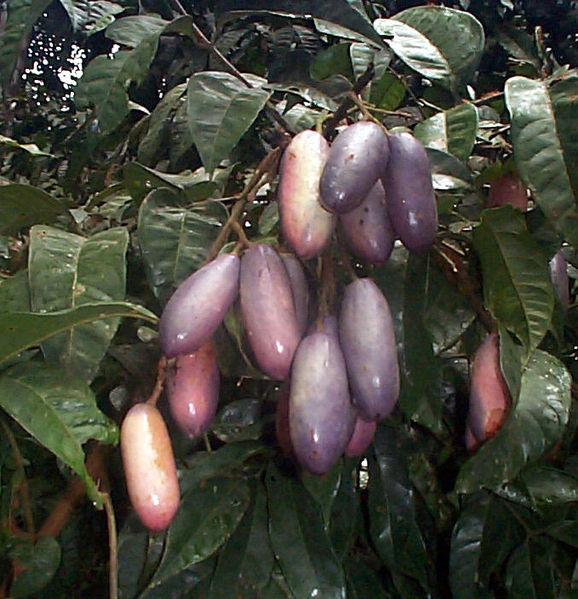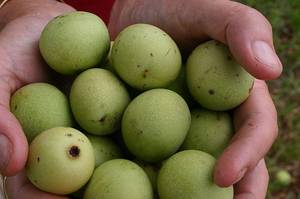Domesticating African Fruit Trees
Interview with
Meera - When many of us think of commercial crops coming from Africa, we think of coffee or cocoa. But the continent is home to some 3,000 species of wild fruit trees which have provided local residents with food and medicine for centuries. These trees are now being domesticated and harnessed in countries such as Cameroon and Kenya, as well as others, in order to boost the economy and meet the nutritional needs of the increasing population. Roger Leakey is a former director of the World Agroforestry Centre and adjunct professor of James Cook University in Australia. He helped develop this program of domestication and explained to me how his team set about doing this...
Roger - The beginning of that process was to go into the communities and to start talking with them and saying, "Which of all the species that you used to collect from forests would you actually like to cultivate?" The answer is nearly always some of the indigenous fruits and nuts. They have high levels of micronutrients, vitamins and minerals. Some of them are high in proteins and oils, so many of them have the dietary requirements that are not in starchy food crops. So I guess the thought is that they can be used to give a more balanced diet.
Meera - Well how did you set about getting farmers to actually start domesticating these and actually creating nurseries of particular trees?
Roger - Well that would turn out to be remarkably easy because they were so enthusiastic. Nobody had ever asked them before what they wanted to do and they instantly started to understand the possibilities once we explained a little bit of very basic genetics. It's quite easy to talk about heritability and the fact that children are different from their parents, from siblings are different from one another, and as soon as you mention that and say, "Well then you can propagate and make multiple copies of the best one..." They instantly cottoned on.
Meera - Another added benefit seems to be the fact that these various fruit trees can be harvested at different times of year. So, is the benefit then of this project also that you can have a continuous supply of various wild fruits?
Roger - Yes, certainly. And indeed, even within some species, we're now seeing that  we actually confined individual trees that fruit out of season. So, if you take the African plum for example in Cameroon, it normally fruits between May and September, but we've now got some cultivars which are fruiting around Christmas. So, we started to see that we can actually extend the productive season by selection as well.
we actually confined individual trees that fruit out of season. So, if you take the African plum for example in Cameroon, it normally fruits between May and September, but we've now got some cultivars which are fruiting around Christmas. So, we started to see that we can actually extend the productive season by selection as well.
Meera - So these fruit trees can be grown in rotation to supply fruit all year round. But what kinds of fruits are actually being grown and just how nutritious are they? Tony Simons is the current deputy director of the World Agroforestry Centre and he filled me in...
Tony - Well, fruit trees provide a number of things. They provide energy, vitamins, micronutrients, water, and also stimulants. And there are literally hundreds of different types of fruit trees. If you take the 33 trees native to the UK, there are only 3 that are essentially fruit trees. That's the crab apple, the hazel and the juniper and those are hardly mainstream fruit trees. Whereas in the Miombo woodlands in southern Africa, there are 75 different fruit trees that provide vitamin A, vitamin C, vitamin E, iron, micronutrients, energy for children etc, and thrse are tremendous contributions to household diets in rural areas.
One of those species is the African plum. The scientific name is Dacryodes edulis and edulis means edible. So this African plant grows in humid forests of west Africa. It is eaten by local people and collected from the wild, but now it's being brought into cultivation because the marketing of it - the growing urban populations love this particular fruit. It is traded across regional boundaries at the level of about $70 million US a year, and it's highly nutritious. It is prized for being eaten cooked and also eaten fresh, and the oil from the seed is also now being used in other food preparations.
 If we go to southern Africa, there's the species Sclerocarya Birrea. Scleo meaning hard, Carya meaning nut, and this particular species is the one that is used in the liqueur Amarula. But it's also used for beer making, it's used as a fresh fruit, and this particular species is also used, the oil of it is used in the food industry - it is a very good oil for sausage machines, etc, as a lubricant when you need a food crude oil. Other fruit species are Vitellaria paradoxa, that is the shea tree. It's traded much more in Europe both as cocoa butter substitute, and also for cosmetic and pharmaceutical products.
If we go to southern Africa, there's the species Sclerocarya Birrea. Scleo meaning hard, Carya meaning nut, and this particular species is the one that is used in the liqueur Amarula. But it's also used for beer making, it's used as a fresh fruit, and this particular species is also used, the oil of it is used in the food industry - it is a very good oil for sausage machines, etc, as a lubricant when you need a food crude oil. Other fruit species are Vitellaria paradoxa, that is the shea tree. It's traded much more in Europe both as cocoa butter substitute, and also for cosmetic and pharmaceutical products.
Meera - What stage is this domestication at at the moment? How much of an increase in production say, has there been, and what are the benefits been so far of this?
Tony - Let's take Uapaca kirkiana from southern Africa. This particular species had wild fruit that were about 10 or 15 grams each. The cultivars, the improved varieties, have fruit that are about 80 or 90 grams. So there's a 5-fold increase in the size of the fruit. There's also have been an increase in the thickness of the skin of the fruit so that it's not attacked by insects. And also, they have a much longer shelf life. So, rather than the three, four-day shelf life, they now have a two or three week shelf life. And we've seen a lot of growth in the horticultural industry in these countries, and Kenya now supply something like $100 million worth of mangoes to the international market, and about $60 million of avocado.
Meera - So that's quite an improvement in terms of both international trade and feeding the population, but what's the next step? And as a result, what's in the future for these African villages? Let's go back to Roger Leakey to find out...
Roger - We started out in two villages in Cameroon, something like 15 years ago now. It's snowballed from there so now we're working with over 450 villages, and more than 7,000 farmers in those villages. The next crucial step is some scaling up, if we're really going to have impact on global poverty, malnutrition, and hunger, then obviously it's got to be scaled up to millions and millions of farmers. I've recently been evaluating the longest running project to date and we found there that there were 31 positive impacts from the project already, ranging from obviously people making money, but people also saying that they're healthier, they're eating better diets, and they're able to send their children to school, and the most exciting one actually from my point of view, I think was young people saying, "We're actually going to see now and we have a future to stay in our village and make money in the villages rather than having to go to the town."
Kat - So, plenty of hope in the future of fruit then. That was Roger Leakey from James Cook University in Australia and Tony Simons, Deputy Director of the World Agroforestry Centre talking to Meera Senthilingam.
- Previous Farming in a Changing Climate
- Next Perfecting the Pea









Comments
Add a comment